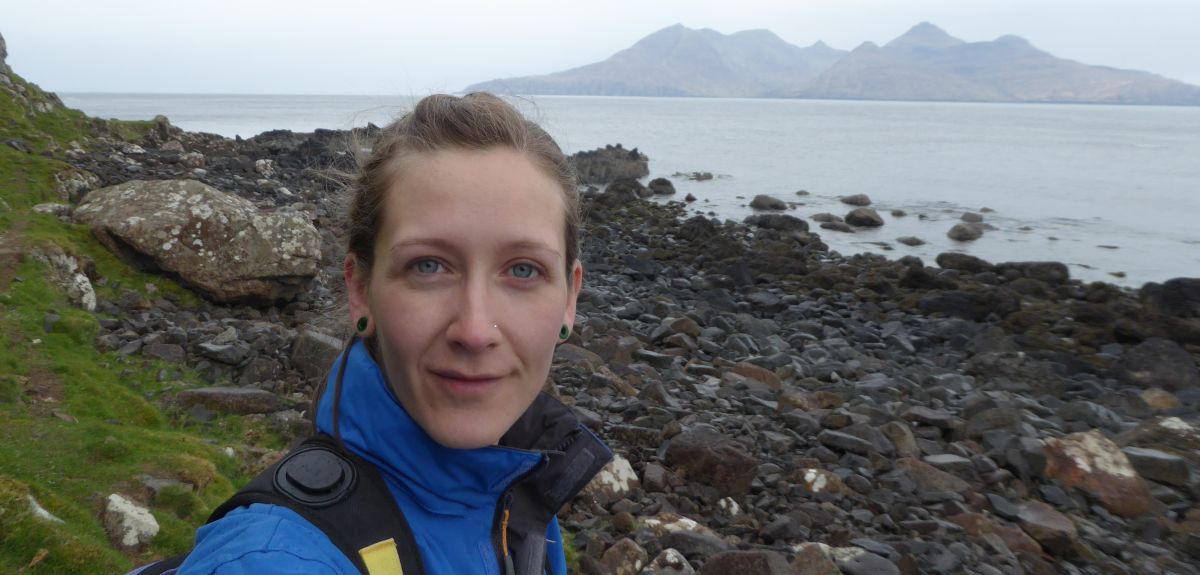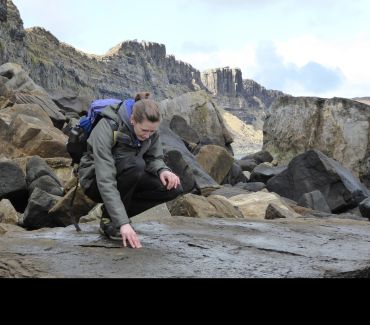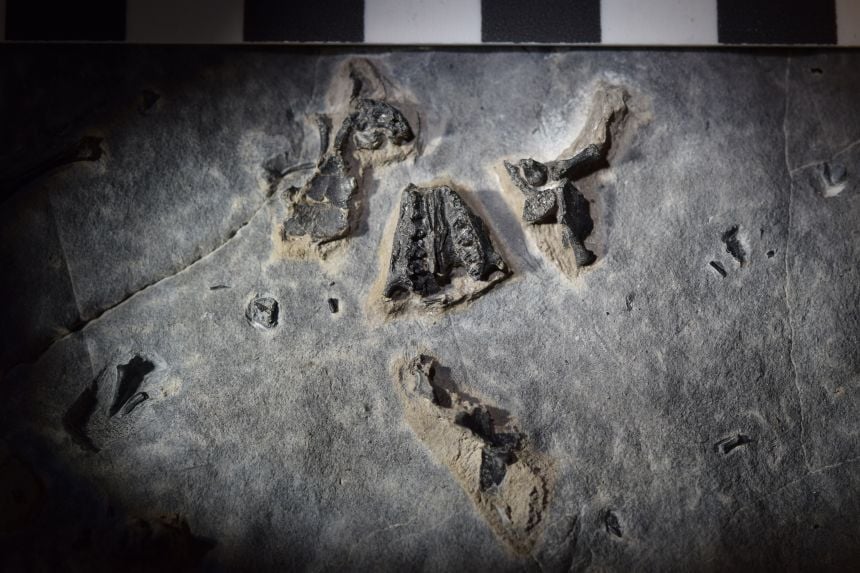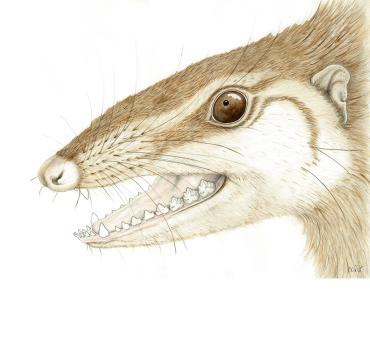
Dr Elsa Panciroli: portrait of a palaeontologist
 Dr Elsa Panciroli during fieldwork on the Isle of Skye. Credit: Elsa Panciroli/Davide Foffa
Dr Elsa Panciroli during fieldwork on the Isle of Skye. Credit: Elsa Panciroli/Davide Foffa
I am a palaeontologist who uses X-ray tomography and digital visualisation to understand the anatomy and growth of the first mammals and their closest relatives. My work focuses on mammals from the Mesozoic, the era of Earth’s history lasting from about 252 to 66 million years ago, comprising the Triassic, Jurassic, and Cretaceous Periods.
Of course, this includes giant dinosaurs, but it is also when the foundations were laid down for all the modern groups of animal life, including mammals, birds, reptiles, amphibians, and lizards.
People often assume mammals only appeared after the asteroid wiped out the non-bird dinosaurs, but that is not the case. Mammals appeared in the Triassic, at the same time as the dinosaurs, they were diverse and exploited a variety of different ecological niches. The group to which mammals belong stretches back even further in time, and is much more exciting than most people realise.
In traditional school text books, the dinosaurs are shown as the dominant species and the mammals as tiny things, almost an afterthought, scurrying away in the background. But these early mammals were actually highly successful?
Yes indeed – mammals may have been small during the Mesozoic but they were undeniably successful little animals. Many were insect-eaters, but there were also herbivores and carnivores. They were playing a fundamental role in the wider ecosystem. Some could glide like flying squirrels, others could dig like moles or were semi-aquatic. Furthermore, they were also doing something really exciting by forming a new, unique type of organism: one with warm-blood and fur that gave birth to live young. This had never been done before.
You have carried out a lot of fieldwork on the Isle of Skye. What makes this site so special?
The Kilmaluag Formation on the Isle of Skye, Scotland, provides one of the richest Mesozoic vertebrate fossil assemblages in the UK, and is emerging as one of the most important globally for Middle Jurassic tetrapods. It compares with localities such as Morrison Formation in North America, or the Yanliao Biota in China. Fewer species have been found on Skye, but they are exceptionally complete and well preserved. I have been doing fieldwork there since 2016, but I grew up in the Highlands and Islands, so the area is very special for me. As someone who loves the mountains, being able to work in sight of the Cuillin always feels special.
What is it like doing fieldwork there?
I mainly work on the southern part of the island, where rocks from the Middle Jurassic are exposed on the seashore and eroded very slowly by the waves. Normally we only have time to visit one site each day and this will be dictated by the tide times. The area is a Site of Special Scientific Interest (SSSI), as well as falling under Scotland’s new Nature Conservation Order (NCO) designation, for its geology, including fossils.
We do not just collect anything on the off-chance it contains a fossil. We make a judgement call on which rocks look the most promising, and only collect those. Usually, only a tiny fragment of fossil is visible on the rock surface and it is often obscured by seaweed and limpets. So it can be hard to tell how much more may be hidden inside.
Tell us about your work at the Oxford University Museum of Natural History (OUMNH)
The OUMNH has an impressive collection of Mesozoic mammal fossils collected locally at Stonesfield and at Kirtlington. They come from the same age rocks as Skye, so I use them to compare with the new Scottish fossils we find. The Stonesfield specimens are the first Mesozoic mammals fossils ever identified, back in the early 19th Century, making them historically important as well as scientifically invaluable. The specimens from Stonesfield are almost entirely individual teeth – no bigger than grains of cous cous. But we can still work out an incredible amount from these, especially using new techniques such as synchrotron scanning to examine the microstructure. From this we can work out their age and how quickly they grew.
Tell us about your book Beasts Before Us - The Untold Story of Mammal Origins and Evolution. How did that come about?
Most books about mammalian evolution start at the end of the Cretaceous, but their evolution stretches right back over 300 million years. I write about the incredible creatures related to mammals that lived long before the dinosaurs. The book also tells untold human tales; of indigenous people who knew about these fossils long before European settlers appeared, and pioneering female scientists who ought to be household names.
I first started writing about these amazing things when I was a Masters student. Eventually, I realised I had more than enough material to write a book. I pulled together all my blogs, published articles and notes, then organised two months to write the book. Then there was a global pandemic… so I ended up with a lot of free time to finish the manuscript. It was published in June 2021, and the feedback has been so positive. I was so excited when The New York Times review called it ‘smart, passionate and seditious’ - I don’t think many books about fossils can claim to incite rebellion! It also led to lots of talks and outreach work.
 Skull bones of the Jurassic mammal Borealestes serendipitus from the Isle of Skye. Credit: Elsa Panciroli
Skull bones of the Jurassic mammal Borealestes serendipitus from the Isle of Skye. Credit: Elsa PanciroliAnd you have a new book out too?
Yes, The Earth: A Biography of Life came out in April 2022. It uses a series of different organisms – including plants, single-celled organisms and animals – to take you through the great events and evolutionary innovations in earth’s history. It is very visual too, with stunning illustrations, including some by the talented palaeoartist Grace Varnham. There are so many amazing stories in evolutionary research I could write a book every year and I still would not tell everything. The book has inspired the upcoming exhibition Connected Planet at the University of Oxford Museum of Natural History; it will explore the oceans, land, and air around us to witness this dynamic connection and see what happens when the balance tips.
You are also quite an artist…
I don’t think of myself as an artist, but I do enjoy creating visual interpretations of the fossil specimens we discover. The art world can be a bit dismissive about palaeoart, and it is sometimes portrayed as just drawing dinosaurs for children. But modern palaeoart is a dynamic and cutting-edge specialism that just happens to depict extinct animals.
Really good palaeoartists need to know a lot about the science of palaeontology, besides animal anatomy and behaviour. These artworks serve a really important purpose in acting as a bridge between scientists and the public.
Were you always interested in geology and ancient mammals?
As a child, I was absolutely fascinated by rocks and used to collect them everywhere I went. But, growing up in the rural highlands (my primary school only had about 15 pupils), I didn’t have access to libraries and museums and I couldn’t learn much about the science of geology, so I would just make up my own names for the rocks I collected. After finishing secondary school, I didn’t know what I wanted to study, so I just started working and did all sorts of jobs from working in garment factories to cleaning houses. I travelled to various countries and in my late 20s I realised the one thing that always interested me was the natural world. So I enrolled at the University of the Highlands and Islands as a mature student to study Environmental Sciences.
At first, I expected to go into conservation, but in one class we looked at palaeoclimatology, and that got me thinking about deep time and the study of rocks and fossils – stuff that was properly old, millions of years. And that was it, my course was set.
 Palaeoart reconstruction of the Jurassic mammal Wareolestes rex. Artist: Elsa Panciroli
Palaeoart reconstruction of the Jurassic mammal Wareolestes rex. Artist: Elsa Panciroli
From there, I did an MSc in Palaeobiology at the University of Bristol, studying ankle bones in fossil mammals. The shape of the ankle is linked to how an animal moves, so I used them to predict whether a fossil species was a digger, a climber, and so on. It is amazing what you can tell about a species’ lifestyle from a single tiny bone.
In 2015 I started a PhD at National Museums Scotland on Scottish mammal fossils from the Middle Jurassic, which is when I started working on the Kilmaluag Formation on Skye. And I have pretty much continued this work up to today, joining Oxford University’s Department of Earth Sciences in 2019. I took up my current role as a Leverhulme Early Career Research Fellow at Oxford University Museum of Natural History in 2020.
What would the young Elsa think of your work now?
I think she would be amazed I was spending my time studying really cool fossils in Scotland. When I was a child, I always wished experts would visit our school and teach us more about rocks and fossils. Remembering this inspired me to create the Scottish Fossil Workshops programme, which was a two-hour workshop I created in 2019. It was specifically designed for primary schools in rural parts of Scotland – places that don’t usually get school visits because they are hard to get to, or don’t have very many pupils. I even returned to my own school.
What is next? Where do you see yourself in the future?
I am not the sort of person who makes 10 or even five year plans, I like to take opportunities as they come. I will definitely keep writing books, and I feel there are so many exciting niches within palaeontology and questions to ask, I could dedicate my entire career to answering them, funding permitting!
 What US intervention could mean for displaced Venezuelans
What US intervention could mean for displaced Venezuelans  10 years on: The Oxford learning centre making an impact
10 years on: The Oxford learning centre making an impact Oxford and The Brilliant Club: inspiring the next generation of scholars
Oxford and The Brilliant Club: inspiring the next generation of scholars New course launched for the next generation of creative translators
New course launched for the next generation of creative translators The art of translation – raising the profile of languages in schools
The art of translation – raising the profile of languages in schools  Tracking resistance: Mapping the spread of drug-resistant malaria
Tracking resistance: Mapping the spread of drug-resistant malaria